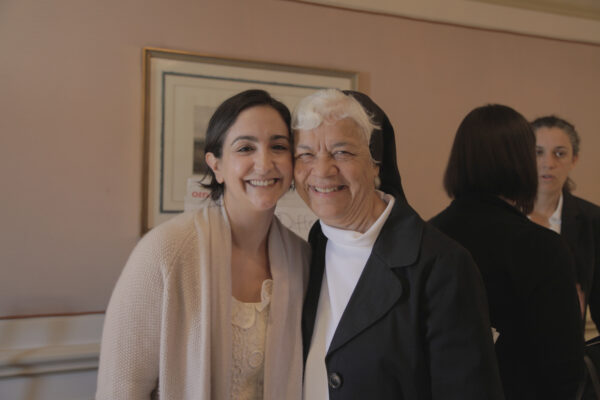Not all nuns look the same.
As a Muslim American with very little exposure to Catholicism, I recently have learned about the diversity of Catholic sisters. This basic lesson has proven to be a door to a more nuanced understanding of female modesty and devotional dress, and it has shown me that Muslim women and Catholic sisters may have more in common than we might think.
At CRCC, I’m currently part of a team evaluating the Conrad N. Hilton Foundation’s Catholic Sisters Initiative, a grant-funding program driven by the desire to help Catholic sisters and nuns, also known as women religious, as they advance human development. I have learned that sisters take different vows than nuns and live and minister actively in the world, while nuns are contemplatives. Like most people, I tend to associate Catholic sisters with the habit, but not all women religious wear it.
In fact, women religious express their vows and religious devotion in their dress in a great variety of ways, colors, forms, uniforms or lack thereof. I have come to find that women religious, like many other women who express themselves through devotional dress and modesty, struggle with the public’s misperception and misrepresentation of their religious choice along with the silencing of their diversity.
The modernizing reforms of the Second Vatican Council asked orders of women religious to re-evaluate their identities and work and return to the spirit of their founders. Many orders found that their founders had dressed modestly in the style of the day in order to best serve those around them. Consequently, many orders did away with habit completely in the late 1960s, while others got rid of stiff wimples in favor of simpler coverings. Still, some Catholics would prefer it if all women religious were habited, arguing that the habit sets the women apart and makes them stand-out more. Even unhabited sisters discuss whether sisters need to wear some sort of uniting symbol. The habit can create a divide among women religious themselves, often marking ideological differences.
Among Muslim women, there have been similar, though less codified negotiations around religious dress historically. One oft cited example is Egyptian feminist Huda Sha’arawi, who removed her face veil in 1923 and ushered in a new wave of conversations around modesty, class and choice in the Middle East. In more recent history, Muslim women have seen their choice of devotional dress become the subject of almost constant debate and crusade, both from within and without.
Muslim women have heard it all: Take off the hijab. Put on the hijab. Your hijab is too low. Your hijab is too colorful. Your hijab is tied wrong. Where is your niqab? Never wear the niqab. Don’t wear pants. It’s okay to wear pants, but not too tight. You get my point.
Much like women religious, Muslim women engage with their creator in a sacred vow that is often expressed in their dress. The public judgment and debate about their decision is common across Catholicism and Islam—as it is within and between Jewish denominations, too.
What Muslim women, globally from my perspective, have learned very acutely and very personally, is that it does not work to dictate what women wear. Whether asking a woman to put on the veil or forcing her to take it off, the result is the same – an assault on her religious freedom. The lesson of the hijab is to embrace diversity.
Writing for Global Sisters Report, Sister Julia Walsh shared that prior to becoming a sister, she didn’t know that some orders of sisters wore plain clothes and others wore habits. “It didn’t take me long to learn about the differences and hear Catholics and sisters express a range of beliefs and feelings — often impassioned — about what expressions of faith showed whether one was faithful and loved God and church,” she wrote. Through Giving Voice, a Hilton-funded project focused on younger women religious, Walsh hopes to “have friendships with all types of Catholic sisters,” not only those who dressed like herself and her order.
The landscape also is ripe for partnership between Muslim women and Women Religious, a partnership that would move conversations beyond what they are wearing, to common priorities, such as advancing human development and combatting xenophobia.
The groundwork has already been laid. In Los Angeles, the Muslim and Catholic Women in Conversation group meets monthly to explore topics such as prayer, rituals and culture, while also putting on joint programming and service activities. The U.S. Conference of Catholic Bishops recently announced it was starting a new national Catholic-Muslim dialogue group, “an initiative driven in part by growing anti-Islamic sentiment that many bishops have denounced.” In the Middle East, there is a long history of partnership among women religious and local Muslim women, who revere Catholic sisters’ devotion to the underserved and have a deep love for Mary, mother of Jesus. In his highly acclaimed Arabic novel, Sitt Marie Rose, for example, author Etel Adnan uses a Catholic nun as his central character to unravel themes of the Lebanese Civil War. Devotional dress opens the door to important conversations around women, faith, choice and service.
In my work with Catholic sisters I have become quite struck by the beauty and variety of devotional dress, whether the various forms of habit, the subtle colors and what they mean, or the way sisters that do not wear a habit express their religious vows through wooden crosses, colorful socks, broad smiles and loose hair. The vitality in the expression of joy and devotion in Catholic sisters’ religious garb, or lack of garb, represents so beautifully the variance of belief and freedom of choice within the vocation. Likewise, the spectrum, beauty and variety of female sacred dress in the Islamic tradition—including mipsters, niqabis, qubaysis or Muslim women who express modesty without the hijab—has always been to me a testament to the diversity within the faith both in the expression of religious belief and personal choice.
There seems to me to be a natural partnership between these two groups of women, Muslim women and Catholic sisters, a space to work together in an interfaith capacity to aid in mutual understanding, dispel misperception, serve the world’s poor and stand with those in need, united, whether with or without the habit and hijab.
Hebah Farrag was the assistant director of research of the USC Center for Religion and Civic Culture through 2023.




